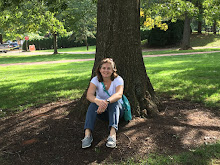The kiln opens from the top.
Sculptures and pots are stacked on vertical shelves supported by columns. Below, you can look down intot he kiln to see the first shelf. Columns will be added next and another shelf stacked on top.
The picture above shows clay that has dried and is ready for a first firing. When it goes into the kiln it is called "greenware." When it comes out, it has been transformed to ceramic and is called "bisque." This firing takes about 15 hours and then another 8 to 12 hours to cool.
The clay in this picture is ready for a glaze firing. The blue pieces are all painted with clear glaze. This can be a bit confusing because it doesn't look very shiny. The glaze gets its color and sheen from the firing process. There is silica in the glaze that melts to form a thin coat of glass covering the clay. This firing only takes about 7 hours but takes 8 to 12 hours to cool.
Below are the same pieces after firing. Notice their sheen and color.





